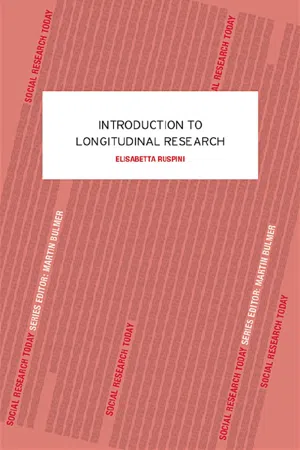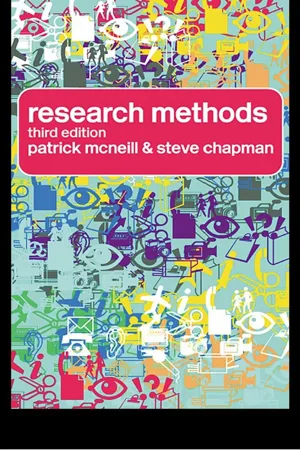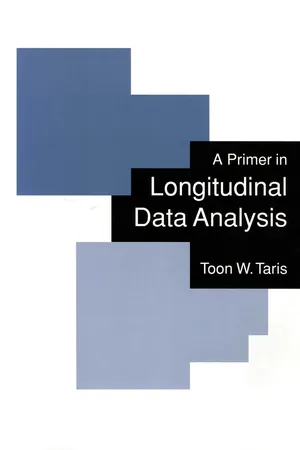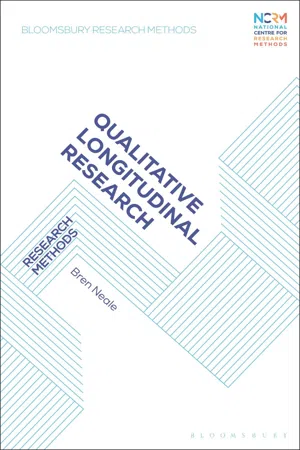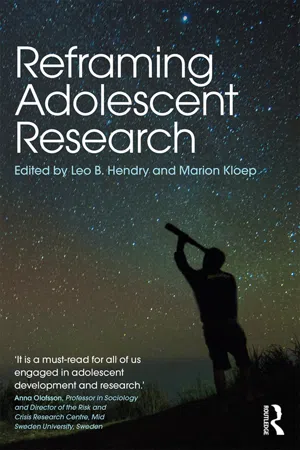Social Sciences
Longitudinal Study Sociology
A longitudinal study in sociology is a research method that involves collecting data from the same subjects over a period of time, often years or even decades. This approach allows sociologists to observe and analyze changes in individuals or groups, providing valuable insights into social behaviors, attitudes, and trends over time.
Written by Perlego with AI-assistance
Related key terms
Related key terms
1 of 4
Related key terms
1 of 3
12 Key excerpts on "Longitudinal Study Sociology"
- eBook - ePub
- Emily Gilbert(Author)
- 2023(Publication Date)
- SAGE Publications Ltd(Publisher)
1 What is longitudinal research?Overview of content
This chapter will provide you with the fundamental and basic information about longitudinal studies. It will answer the key question, ‘What is a longitudinal study?’ and then explain the advantages and disadvantages of using a longitudinal methodology to conduct research.Some of the advantages and disadvantages introduced in this chapter will be expanded on further in separate chapters in this book, and this is signposted where necessary.As well as a practical explanation of longitudinal studies, the chapter will also provide a short introduction to one of the major theoretical issues associated with longitudinal studies – developing a theory of change.Learning outcomes
After you have read this chapter, you will be able to:- understand what a longitudinal study is;
- describe the benefits of carrying out research using a longitudinal methodology;
- describe the drawbacks of longitudinal studies;
- understand what a theory of change is.
What is a longitudinal study?
At its most basic, alongitudinal studyis one that follows the same subjects over time, taking repeated measures from them. By taking repeated measurements over time, a longitudinal study is a method by which to study change. Longitudinal studies can last weeks, months or even years. By following the same subjects for so long, researchers can see how different things change or stay the same over time, such as attitudes, behaviours, health conditions, educational or career paths, or relationships and family structure. This stability or change can also be looked at in relation to past events or experiences, establishing how certain events and experiences can impact on various outcomes.The subjects followed by longitudinal studies are called ‘sampling units’. Sampling units are the single items that make up the population of interest. Thepopulation - eBook - ePub
- Elisabetta Ruspini(Author)
- 2003(Publication Date)
- Routledge(Publisher)
Part I Longitudinal research
Passage contains an image
1 What is longitudinal research?
The term ‘longitudinal’ will be used here to describe what can be defined as the minimum common denominator of a family of those methods which tell us about change at the individual micro level (Zazzo, 1967; Menard, 1991). This family is the opposite of that described by the term ‘cross-sectional research’.‘Longitudinal’ is a rather imprecise term. Longitudinal data can be defined as data gathered during the observation of subjects on a number of variables over time. This definition implies the notion of repeated measurements (van der Kamp and Bijleveld, 1998). Basically, longitudinal data present information about what happened to a set of units (people, households, firms, etc.) across time. The participants in a typical longitudinal study are asked to provide information about their behaviour and attitudes regarding the issues of interest on a number of separate occasions in time (called the ‘waves’ of the study) (Taris, 2000). In contrast, cross-sectional data refer to the circumstances of respondents at one particular point in time (I shall expand on these points later). Thus, the term ‘longitudinal’ refers to a particular type of relationship between phenomena: the type which evolves over the course of time and is termed diachronic, the opposite of synchronic - eBook - ePub
Research Design
Succesful Designs for Social Economics Research
- Catherine Hakim(Author)
- 2012(Publication Date)
- Routledge(Publisher)
8 Longitudinal studies DOI: 10.4324/9780203354971-8 Regular surveys and longitudinal studies are the two designs that most explicitly focus on social change processes, but they do so in different and complementary ways. Regular surveys provide information on net change at the macro-level, while longitudinal studies provide information on the much larger volume of gross changes (or flows) at the microlevel (see Chapter 7). Longitudinal studies are often initiated when regular surveys or other sources reveal new trends that they cannot fully describe or explain (especially if they do not contain a panel element). The longitudinal study is unique in its ability to answer questions about causes and consequences and hence to provide a basis for substantiated explanatory theory. The prospective longitudinal study takes a single sample or group and follows it up, with repeated data collections, over a long period of time (see Figure 1). Strictly speaking, the term longitudinal study refers only to prospective studies. The retrospective study, which is quicker and cheaper, is considered below as a quasi-longitudinal design. Longitudinal studies cover a ‘long’ period of time, although what is considered a long period of observation depends on the subject-matter and context, and the issues addressed. Studies of people experiencing a spell of unemployment may continue for only one or two years, while studies of human growth and maturation may continue for 30 years or longer. Generally, there are numerous data collections in order to collect information on changes as they are happening - eBook - ePub
Children in Immigrant Families Becoming Literate
A Window into Identity Construction, Transnationality, and Schooling
- Catherine Compton-Lilly, Stephanie Shedrow, Dana Hagerman, Laura Hamman-Ortiz, Yao-Kai Chi, Jieun Kim, Sun Young Lee, Kristin Papoi, Erin Quast, Brooke Ward Taira, Bingjie Zheng(Authors)
- 2022(Publication Date)
- Routledge(Publisher)
McLeod and Thomson (2009) noted that sustained research with the same individuals or groups of people over long periods of time is fairly rare, longitudinal accounts are essential for making sense of people’s long-term experiences, including their school experiences. Qualitative longitudinal research invites researchers and readers to glimpse emerging and often invisible dimensions of being human. This is one explanation for the international success of the British television series 7 Up (Apted, 1964 – present). By returning to watch these episodes as they are released every seven years, we not only learn about people across time but we are also compelled to think about ourselves – who we are and who we might become.Longitudinal research has a long history across disciplines including anthropology, psychology (e.g., developmental studies), health studies (e.g., the progression of disease), and sociology (e.g., life course studies, policy impact studies) (Holland, Thomson, & Henderson, 2006 ). These longitudinal projects track individual lives, explore social change in communities, reveal the experiences of cohorts of people who have shared particular experiences (e.g., participants in the Chinese cultural revolution, survivors of 9/11), and explore institutional change. For example, anthropologists spend long periods of time working in particular communities. They craft thick descriptions and document changes in those communities. Similarly, ethnography and ethnographic methods have proven to be particularly powerful tools for educational researchers who spend significant periods of time in schools and classrooms. A longitudinal presence allows researchers to identify, observe, and document change as it happens in particular spaces across time.As Compton-Lilly completed her doctorate in the late 1990s. The students on the research team worked on their doctorates in the 2010s, we read some of the same longitudinal studies and these studies influenced our decision to engage in longitudinal research. For example, we had all read Heath’s (1983) classic longitudinal ethnographic study that was conducted between 1960 and 1970. This study focused on communicative events in two rural communities, one white and one Black and two urban communities, one white and one Black. In this project, Heath was particularly interested in how children were “socialized as talkers, readers and writers” (p. 6) in response to “the details of the daily existence of children” (p. 6). While this initial study was primarily descriptive, in an extension of that research which tracked some of these same families across 30 years, Heath (2012) - eBook - ePub
Advances in Environmental Psychology (Volume 5)
Methods and Environmental Psychology
- Andrew Baum, Jerome E. Singer(Authors)
- 2020(Publication Date)
- Routledge(Publisher)
For our purposes, the crucial point about these differing figures is that they could have been found out (without unduly trusting people’s memories) only by questioning the same people repeatedly—that is, by a longitudinal (or panel) study rather than a cross-sectional one. A cross-sectional study could only have estimated the number of poor in the year of the study, giving no data (except based on fallible memory) on the number of persistently or occasionally poor. The difference is like that between a snapshot of a crowd where we can make some aggregate measure, such as the number of people present, and a motion picture in which we can see the aggregate size of the crowd at each moment and also follow the activities of individuals as they leave or enter the crowd over time. The implementation of such large-scale longitudinal studies gained impetus in the early 1960s (Kalachek, 1979).Advantages of Longitudinal Studies
The distinctive feature of a longitudinal study is that it permits an investigator to follow people (or other individual units of analysis, e.g., families, organizations) over time; this means that data on individual changes, rather than only aggregated movements, are available for analysis. Thus research can focus on process by asking “how” and “why” and often “for whom” such changes occur. For example, in studying life-cycle processes a panel study might address such a question as “Does early unemployment among teenagers and youth represent a transitory phase that many go through with no particular long-run adverse consequences, or does such a period of unemployment lower future earnings and/or increase the proportion of time in later life that an individual is unemployed?”Longitudinal surveys are also particularly useful for the collection of cross-sectional data, if the period of time one wishes to consider is not instantaneous. Hence the successive interviews in NCS and in the survey of pesticide use are useful for bounding victimizations within the 6-month reference period and pesticide acquisition/disposal within the 5-month reference period, respectively. Similarly, the longitudinal design for the National Medical Care Utilization and Expenditure Survey permits a full year’s worth of data to be accumulated for each family, so that families can be distributed according to utilization of healthcare facilities and their costs. - eBook - ePub
- Steve Chapman, Patrick McNeill, Patrick Mcneill(Authors)
- 2005(Publication Date)
- Routledge(Publisher)
The research team also needs to be held together. Work like this requires continuing enthusiasm of a kind that may not outlast the departure of the original members and their replacement with new people.Lastly there is the question of cost, always important with social research, and particularly so here. Most funding agencies are, understandably, unwilling to take on a commitment to pay for research over a period of perhaps twenty years or more. Most of these studies have had a struggle to remain solvent, and have depended on the generosity of charitable foundations such as Nuffield and Ford, as well as finance from government agencies, often via the health services. In addition, they have made use of health visitors and others as free interviewers.In addition to the panel version of longitudinal studies, surveys can be repeated at intervals though with different groups of respondents. This is the design of the annual series British Social Attitudes (e.g. Jowell et al. 1985–99) and of the British Crime Survey (e.g. Hough and Mayhew 1983, 1985; Mayhew et al. 1989; Mirlees-Black et al. 1998).Before leaving the topic of longitudinal studies, it is worth pointing out that the Census can be seen as an example. Carried out every ten years since 1801, with the exception of 1941, it has most of the characteristics of the longitudinal survey except, of course, that it is a study of the whole population rather than a sample. Until recently, it has not been possible to use the Census to follow a particular group of people through their lives but it is perfectly feasible to study the changing population structure of, say, a particular district. It is invaluable to the sociologist who wishes to trace broad patterns of social change, and to make comparisons between the social conditions of one period and another (see also pp. - eBook - ePub
- Karin Sanders, Julie Cogin, Hugh Bainbridge, Karin Sanders, Julie A. Cogin, Hugh T.J. Bainbridge(Authors)
- 2013(Publication Date)
- Routledge(Publisher)
Longitudinal ResearchTimothy C. BednallAfter reading this chapter, we expect you to be able to:- Understand the added value of using a longitudinal research design;
- Be able to design a longitudinal study, including the number, spacing, and timing of assessments;
- Gain an understanding of strategies for recruiting and retaining participants;
- Understand strategies for dealing with missing data;
- Test the assumption of longitudinal measurement equivalence;
- Understand the three major families of longitudinal research.
1 . Introduction
Longitudinal research refers to studies that investigate change over time. Usually, such studies involve repeated assessments of one or more variables of interest. This chapter provides an introduction to longitudinal research designs and discusses them within a structural equation modeling (SEM) framework. It discusses methodological challenges associated with developing and testing longitudinal models, and presents strategies for overcoming them. It provides an overview and examples of three major families of longitudinal research: (1) change score models, (2) autoregressive and cross-lagged panel models, and (3) latent growth models. Applications of these basic models are discussed. Other approaches to longitudinal data analysis are also briefly reviewed.2 . What is the Added Value of Longitudinal Research?
Longitudinal research offers numerous advantages over cross-sectional studies, in which data is collected only at a single point in time. In general, longitudinal studies allow researchers to determine how individuals typically change over time, including whether change is swift or gradual, and whether the rate of change remains constant. They permit researchers to determine whether other factors predict differences - eBook - ePub
- Toon W Taris(Author)
- 2000(Publication Date)
- SAGE Publications Ltd(Publisher)
Basically, longitudinal data present information about what happened to a set of research units (such as people, business firms, nations, cars, etc.) during a series of time points (for simplicity, I will refer to human subjects throughout the remainder of this text). In contrast, cross-sectional data refer to the situation at one particular point in time. Longitudinal data are usually (but not exclusively) collected using a longitudinal research design. The participants in a typical longitudinal study are asked to provide information about their behavior and attitudes regarding the issues of interest at a number of separate occasions in time (also called the ‘phases’ or ‘waves’ of the study). The number of occasions is often quite small – longitudinal studies in the behavioral and social sciences usually involve just two or three waves. The amount of time between the waves can be anything from several weeks (or even days, minutes, or seconds, depending on the aim of a study) to more than several decades. Finally, the number of participants in the study is usually fairly large (say, 200 participants or over; sometimes even tens of thousands).Although longitudinal research designs can take on very different shapes, they share the feature that the data describe what happened to the research units during a series of time points. That is, data are collected for the same set of research units for (but not necessarily at) two or more occasions, in principle allowing for intra-individual comparison across time. Note that the research units may or may not correspond with the sampling units. For example, in a two-wave longitudinal study on the quality of the care provided by a children’s day care center (the research unit), a different sample of parents (the sampling units) may be interviewed at each occasion. The aggregate of the parents’ judgements at each time point will allow for conclusions about changes in the quality of the care provided by the center, even if no single parent has been interviewed twice.As another example, take the consumer panel - eBook - ePub
Unfolding lives
Youth, gender and change
- Thomson, Rachel(Authors)
- 2011(Publication Date)
- Policy Press(Publisher)
The emergence of an explicitly named ‘qualitative longitudinal method’ is a recent development (Thomson et al, 2003; Saldana, 2003). Interest in such an approach has been fuelled by a range of factors. First, such methods offer the potential to escape the limitations of qualitative interview-based studies. By generating a ‘movie’ as opposed to a ‘snapshot’ (Nealeand Flowerdew, 2003), the longitudinal method appears to get beneath accounts, making visible contradictions between successive accounts and between intentions and practices (Plumridge and Thomson, 2003). Second, longitudinal methods are suited to gaining insight into phenomena that change over time. Where the focus of the research has an important sequential dimension, as with the example of the ‘career’ (be it educational, sexual, drug, crime, or work related) it is useful to be able to follow individuals or groups over time.Longitudinal methods are also suited to an exploration of the relationship between agency, structure and serendipity – when questions of timingare important to a particular study. In some respects the model here comes from quantitative methods, where a longitudinal approach captures the accumulation and interplay of different factors in the determination of outcomes (Elliot et al, 2007). But qualitative longitudinal studies can do more than putting flesh on the bones of quantitative knowledge: such studies may also provide insight into the humanmethodologythrough which risks and opportunities are mediated – ‘the art of life’ (Rutherford, 2000), ‘the reflexive project of self’ (Giddens, 1991), ‘the temporality of action’ (Adkins, 2005). It has been argued that the current emphasis on change and contingency in political and theoretical discourse can be seen as part of a paradigm shift to a sociology ‘post social structure’ (Urry, 2000; Adkins, 2002a). If this is the case, then longitudinal and qualitative research could be seen as an important methodology for shifting attention from the synchronic analyses that privilege the representation of social structure, towards diachronic analyses which privilege processual and temporal themes such as the interplay of risk and resilience in the context of biography (Thomson and Holland, 2003b). - eBook - ePub
- Pamela Davies, Peter Francis(Authors)
- 2018(Publication Date)
- SAGE Publications Ltd(Publisher)
For researchers, money matters, and life-course research is usually expensive. It takes a lot of time, meaning more work and more research hours, and often creates (even) more methodological issues than most other forms of research in social science. It is therefore highly reasonable to pose the question and demand an answer from its advocates: why do this form of research at all, and why has it become so prominent over the last three decades?Because, using this methodology, we can answer important research questions which other methods have trouble addressing. The foremost questions in this regard concern the issue of continuity and change in behaviour over time.To contrast life-course research, consider so-called cross-section methodology. Here, researchers study a sample or a population at a single, specific moment in time. The resulting data gives us the possibility to study individuals or groups of individuals when it comes to a whole range of variables (such as crime, peer relations, health, employment, and so on), and how these are related to each other. We commonly call these between-individual similarities and differences. Using longitudinal methodology, we study the same individual at repeated points in time. Since we can study the relationship between the different variables as we go through time, we can also see whether the relationship between them is constant or changes over time. It is likely, for example, that as long as the individual engages in repeated, serious crime, he or she will have a relatively unstable form of conventional work (if he or she has a job at all), have turbulent relationships with other people, have increasing problems with mental and physical health, etc. Whether or not this is the case becomes impossible to study using cross-sectional research design – it would have to be inferred by theory.We can also study what happens when change occurs in one of the variables: is there a change in a person’s criminal offending when he or she gets a more stable job, starts a romantic relationship or becomes ill? Crucially, we can also – sometimes – study which change occurs before the other, i.e. does a person’s criminal offending change as a result of them getting a job etc., as Sampson and Laub (1993) argue, or is it the other way around – a person begins to decrease their criminal offending and then - eBook - ePub
Qualitative Longitudinal Research
Research Methods
- Bren Neale(Author)
- 2020(Publication Date)
- Bloomsbury Academic(Publisher)
the Longitudinal Harlem Adolescent Health Study, Brunswick 2002), while a nationally representative study (e.g. the 1958 cohort of the National Child Development Study) will recruit many thousands. Either way, these studies illuminate large-scale patterns of change based on very large datasets. Panel members are likely to be asked a series of semi-structured questions at regular intervals (typically every year for a longitudinal panel study, and five years for a birth cohort study, Ruspini 2002: 4). In general, then, tempos tend to be well regulated and extensive, with time frames stretching over several decades of change. Given the scale of these studies, the focus tends to be on what changes, for whom, on the direction and extent of change and on where, when and how often change occurs. Data on the spells of time that people spend in particular states, for example, in the states of poverty or cohabitation, produce a broad, chronological picture of change across a study population (Leisering and Walker 1998). This creates a bird’s-eye view of the social world, a ‘long shot’ that is panoramic in scope. The result is an epic movie, a highly valuable ‘surface’ picture of social dynamics. However, it is a movie in which the intricacies of the plot and the fluid twists and turns in the story line are hidden from view (Neale and Flowerdew 2003). Qualitative longitudinal research QL research, in contrast, is located within the qualitative, interpretivist tradition (Ritchie and Lewis 2003). It has an equally venerable history. Van Gennep (1960 [1909]) was one of the earliest dynamic thinkers. In The Rites of Passage he conducted a secondary analysis of comparative data on the ritualized processes of birth, initiation into adulthood, marriage and death. This enabled him to develop insights into life course transitions that were in tune with local meanings and mechanisms of change - eBook - ePub
- Leo B. Hendry, Marion Kloep(Authors)
- 2018(Publication Date)
- Routledge(Publisher)
Box 4.1 ), which at a general level boil down to two overarching questions: How does the same individual change over months and/or years (i.e. intra-individual or within-person change) and what are the causes of change (for a historical overview, see, e.g. Voelkle and Adolf, 2015). However, modern theories highlight (at least) two other rationales for longitudinal research: testing heterogeneity in developmental mechanisms (or inter-individual differences in the causes of intra-individual change) and assessing the non-stationarity of processes on different time scales (or changes in the cause(s) of intra-individual change over time). Could novel longitudinal research methods help researchers to set these conceptual steps?BOX 4.1 FIVE RATIONALES FOR LONGITUDINAL RESEARCH1 The direct identification of intra-individual change2 The direct identification of differences in intra-individual change3 The analysis of interrelationships in behavioural change4 The analysis of cause of intra-individual change5 The analysis of causes of inter-individual differences of intra-individual change(Baltes and Nesselroade, 1979)As researchers nowadays, we have the luxury of an almost overflowing toolbox of analytical techniques for longitudinal data, each of them with fancy names such as latent growth curve models (LGCM), growth mixture models (GMM) or random-intercept cross-lagged panel models (RICLPM). Moreover, new methods of collecting data continually emerge. For instance, with almost every teenager being equipped with a smart phone nowadays, we no longer have to rely on assessments with long intervals (i.e. the photo-album of development). We can also track adolescents as they go through their daily lives, by asking several times a day how they are feeling, behaving, and interacting with others. These so-called experience sampling methods (ESM; Larson and Csikszentmihalyi, 1983) are not new, but are increasing in popularity at a quite rapid pace (Hamaker and Wichers, 2017). The intensive longitudinal data or time series data that result from ESM studies can be used to obtain a ‘flip-book’ of short-term developmental processes. But rather than bringing us an easy fix to finally grasp the developmental mechanisms described in ecological and dynamic theories of development, this increase in methodological possibilities might actually be positively correlated with an increase in confusion among researchers.
Index pages curate the most relevant extracts from our library of academic textbooks. They’ve been created using an in-house natural language model (NLM), each adding context and meaning to key research topics.
Explore more topic indexes
Explore more topic indexes
1 of 6
Explore more topic indexes
1 of 4

